I’ve come to a conclusion: community gardens are the perfect places for extroverts to get some alone time.
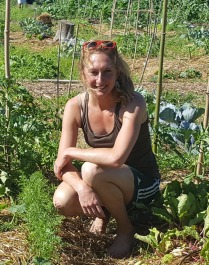
Author enjoying alone time in her garden (…but grateful for the neighbor who took the picture!)
I came to this conclusion after initially feeling left out when our garden instructor, Joe, proclaimed that gardening was a perfect hobby for an introvert, because “you get two gardeners together, and they can talk shop forever!” he said. Well, after being in the Neighborhood Farm Initiative community gardening program for a few months and clocking many revitalizing hours just me with my plants, I can say that gardening – particularly community gardening – is the perfect setting for an extrovert like myself to get the alone time we also need, but while basking in the energy of being surrounded by fellow farmers who also are “just with their plants.”
Many friends have expressed surprise at how much I rave about my time gardening with the Neighborhood Farm Initiative’s program. “Don’t you do that for work already?” they ask quizzically. While it’s true that I am a Cooking and Gardening teacher at Mundo Verde Bilingual Public Charter School and I find my time gardening with the students extremely rewarding, it is certainly a different vibe from being “just with the plants.” In fact it often looks like this:
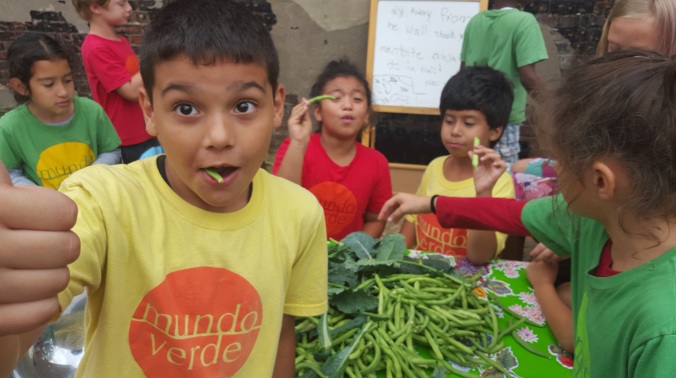
Exhibit A: The school garden bean harvest turns into a school garden mass feast.
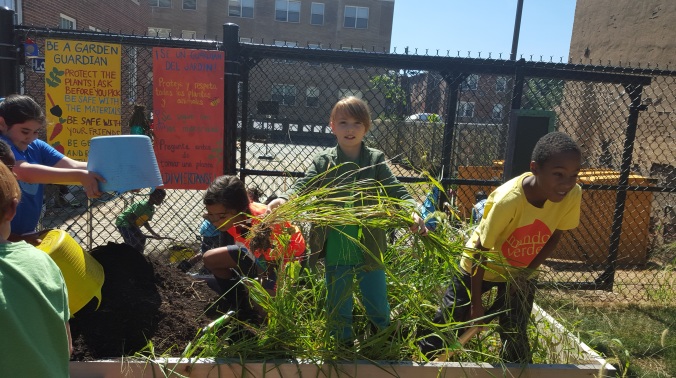
Exhibit B: Tidying up the garden turns into a soil and weeds free-for-all.
As a single, child-less extrovert, I tend to overbook my evenings and weekends with social activities. But at least twice a week it’s just me and the garden for a few hours. I crouch down to get at plant level and lose myself in methodical weeding, searching for just the right radishes to harvest, or suckering the tomatoes.
Then, from time to time I resurface from my garden plot bubble, and see what’s going on with my neighbors. It always feels a little like waking from a dream to me.
“What great lettuce!” My plot neighbor, Doienne, compliments me.
“Thanks!” I beam.
“Do you think I should harvest my cabbage?” she points to her own plot. We inspect together the cabbage and discuss the pros and cons of harvesting now versus later. Well they’re kind of small….but the cabbage moths are picking up, you don’t want to lose it to pests…
“You know truthfully, I don’t really care for cabbage anyways, I just wanted to see what it would be like to grow it!” she laughed. Eagerly I offered to trade her some of my extra lettuce for her cabbage. As we made the exchange I had the feeling that we were enacting a scene as old as humankind; the sharing of our food. After all, before the days of NFI gardening classes the only way people learned better ways to grow their own food or added unexpected diversity to their garden harvest was through their neighbors!
“Man, there is hardly an inch of bare soil in the sweet potato plot” I said, gazing at the plot a few rows down from us. Sweet potatoes take up so much space with their sprawling almost weedy vines that NFI had relegated them to their own plot instead of giving a few to each farmer.
I was disappointed that the sweet potato slips in the school garden had for some reason not taken, and I was afraid that it was too late in the season to get any real tubers this year if I started over.
Doienne said thoughtfully, “You know, where I’m from in West Africa, it’s actually more common to eat the leaves of the sweet potato plant!” I tore one off and chewed slowly. The dark green heart-shaped leaf was far softer than I had anticipated, and very mild in flavor. I took several cuttings of sweet potato vines to take back to the school garden, excited to share this new discovery with my students.
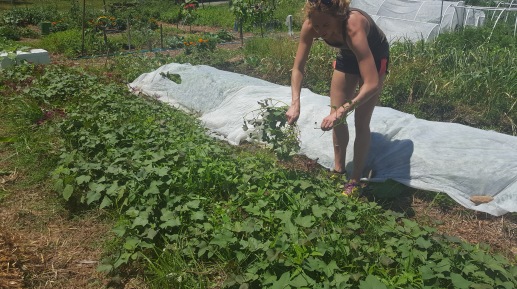
Author taking cuttings from the NFI sweet potato garden bed for replanting in the school garden. To get them to reroot, I pulled off all the leaves from the vine except for the ones at the very tip, then planted the vine just below the surface along the whole length with just the tip sticking above ground. Roots will soon sprout out of the open wound left by the removed leaves.
Thanks to our exchange in the garden, even if I don’t get full tubers this season, I’ll be sure to cook with my students a sweet potato vine stew of sorts. Next time I’ll ask Doienne her favorite recipe from home!
Doienne said good-bye and I knelt down by my tomato plants once more. Garden bubble resealed, alone-time recommenced.
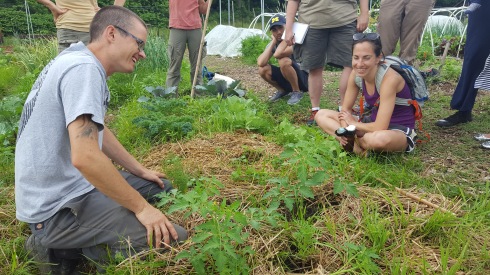
Joe, NFI Instructor, showing Kitchen Garden Education students how to sucker their tomato plants. (We might be laughing at the word “sucker,” who knows.)
Suckering tomatoes is perhaps my favorite gardening activity. “Suckering” a tomato means that you remove the extra stalks (or suckers) that have sprouted between the primary tomato ‘trunk’ and it’s fruit-bearing branches. These sucker stalks are essentially starting mini tomato bushes off of the main one. The problem is that leaving these extra limbs of the tomato plant can make the plant a chaotic place. When too many branches shoot off the trunk, resources are drawn away from the production of fruit. The plant also becomes too crowded and aeration is reduced, leading to greater risk of disease in the plant. I gaze empathetically at one of my tomato plants. My busy life, full to the brim of ambitions, commitments, and activities can sometimes seem like a tomato plant with suckers shooting off every which way, draining energy from the main trunk. But I’m learning to simplify, to choose more wisely where to channel my energy, to nip away the excess suckers, and recognize where my true strength (my trunk) lies.
Shaking my head in amusement I stood up, leaving my garden bubble. I had drifted into the deep end of philosophizing; always a sign that it’s time to go home and cook dinner. And cabbage was on the menu!
Blog post by Tara McNerney, 6/29/16